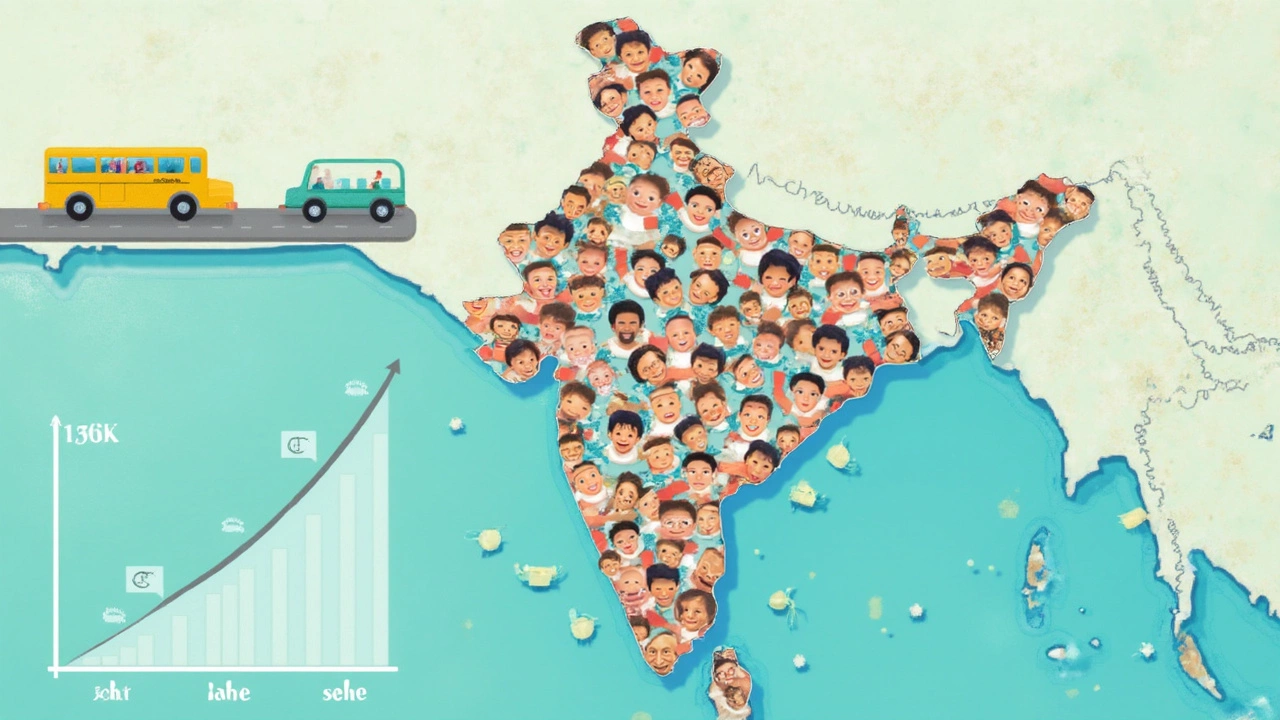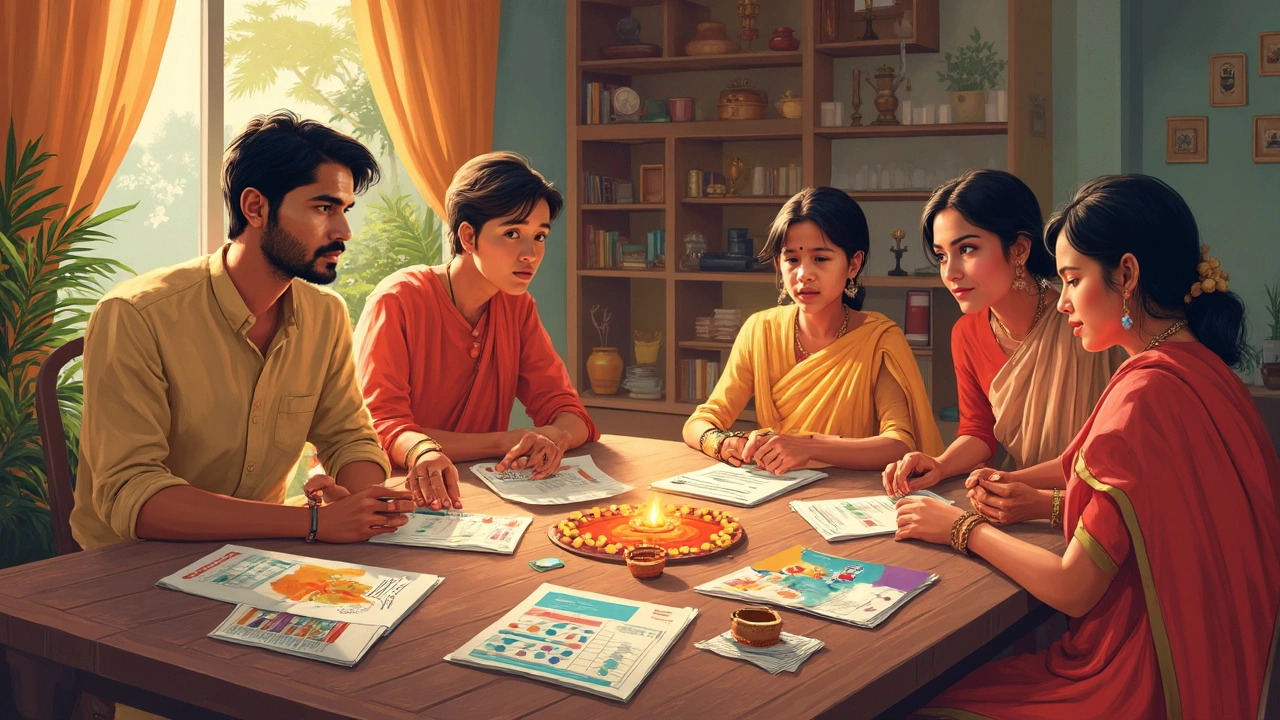Ever wondered just how massive the CBSE board really is in India? Try wrapping your head around this: in 2024 alone, over 36 lakh students registered for the Class 10 and 12 CBSE exams. That's practically a small city cramming into exam halls every year. And we're not even counting the millions more in lower classes from Grade 1 onward, all following the same CBSE syllabus.
These numbers aren’t just random trivia. They actually show how much trust parents and students put into the CBSE system for that all-important national-level schooling. If you’re confused about CBSE’s total reach, or why people stress about board exams, understanding these stats puts things in perspective. Stick around. There’s a lot you probably never thought about when it comes to just how many students are in the game—and what it means for your school life or your kids’ education.
- CBSE Board by the Numbers
- Breakdown by Class and Region
- Enrollment Trends and Recent Changes
- Implications for Students and Parents
- Useful Tips for Navigating CBSE
CBSE Board by the Numbers
The scale of the CBSE board in India is almost hard to believe. With over 28,000 schools affiliated (as of last year), you’ll find CBSE classrooms tucked in every corner of the country—from massive city campuses to tiny hill town setups. And that’s not just inside India; there are around 240 CBSE schools spread across 28 other countries. So if you ever feel lost in the crowd, you’re definitely not alone.
Let’s talk concrete numbers. In 2024, according to official CBSE statements, a whopping 21.5 lakh students appeared for Class 10 board exams, while about 16 lakh sat for Class 12. Now add millions more studying in grades 1 to 9 and 11, and the total enrollment under the CBSE umbrella easily crosses 40 million students every year. That’s like the entire population of a big state all following the same books, exams, and guidelines.
Here’s a snapshot to show just how the numbers stack up for the board exams:
| Exam | 2023 | 2024 |
|---|---|---|
| Class 10 | 21,86,940 | 21,50,000+ |
| Class 12 | 16,96,770 | 16,00,000+ |
These figures shift a bit each year, depending on factors like changing school policies, the number of affiliated schools, and big events like the pandemic. No matter what, the CBSE board keeps growing. It’s the biggest board in India, dwarfing even state and international boards in sheer reach.
Why does this matter? Larger numbers mean more competition, more exam centers, bulk printing of textbooks, and a huge focus on standardization. If you apply for a school or appear for a CBSE exam, you’re sharing the experience with millions across the country and even beyond.
Breakdown by Class and Region
The CBSE board isn’t just a big crowd; it’s also seriously spread out. If you look at the numbers by class, you’ll notice the jump as kids move up. For example, CBSE’s official 2024 data shows about 20 lakhs taking the Class 10 exam, but only around 16 lakhs making it to Class 12. That’s some serious competition—plus, a lot of families switch boards after Class 10 if their kids want to try state curriculums or specialized courses.
Beyond just grade levels, the regional split is also interesting. Most CBSE schools cluster in urban areas—think Delhi, Mumbai, Bangalore, and Hyderabad. Delhi NCR is like the CBSE capital, with over 1,000 schools under the board, and the number of test-takers in this region alone is close to 4 lakhs every year. South India’s big metro cities are catching up fast, especially with families chasing engineering and medical dreams.
But it’s not just city schools—CBSE has reached way out into smaller cities and even some rural towns thanks to government initiatives. States like Uttar Pradesh and Rajasthan now have hundreds of CBSE-affiliated schools, making this a nationwide network. You’ll spot CBSE institutions even in hill towns, oil townships, and wherever central government staff are posted—places my dog Paco and I have driven through on road trips.
Here’s what’s wild: there’s a mini CBSE universe outside India too! More than 200 schools in foreign countries, especially in the Middle East and Southeast Asia, use the same curriculum to keep up with what’s happening back home.
- Class 10: Over 20 lakh students wrote the board exam in 2024.
- Class 12: Around 16 lakh students sat for the exam, showing noticeable drop-off after Class 10.
- Delhi NCR alone: 1,000+ affiliated schools and about 4 lakh exam-takers per year.
- Uttar Pradesh & Rajasthan: Hundreds of schools each, with enrollments growing.
- International: 200+ schools follow CBSE outside India, mainly in the Gulf region.
This breakdown proves just how widespread—and diverse—the CBSE student base is, not just across India but around the world.

Enrollment Trends and Recent Changes
The headcount for students under the CBSE board hasn’t just stayed high; it’s actually kept climbing. Back in 2018, the board handled around 31 lakh exam registrations for Class 10 and 12 combined. Fast forward to 2024, and that number crossed 36 lakh. That’s a climb of more than 16% in just six years—pretty wild, right?
| Year | Class 10 Students | Class 12 Students |
|---|---|---|
| 2018 | 16.3 lakh | 11.9 lakh |
| 2020 | 18.9 lakh | 12.0 lakh |
| 2022 | 20.2 lakh | 14.4 lakh |
| 2024 | 21.8 lakh | 14.6 lakh |
One big reason for these hikes? More private schools have jumped on the CBSE board, especially in rural and smaller cities. After the COVID-19 pandemic, parents started picking CBSE over state boards for its online learning, consistent syllabus, and national recognition. The board responded by launching remote classes and exam support, making it more appealing for families wanting flexibility and stability.
Here’s something else. Enrollment from North India, especially Delhi, Uttar Pradesh, and Haryana, has always been strong. But now, South Indian states like Tamil Nadu and Karnataka are seeing a spike in CBSE school affiliations. The board now claims more than 28,000 schools across the country—and that number still rises each year.
- CBSE relaxed documentation rules for online admissions, making sign-ups easier.
- Exam pattern updates in 2023 focused more on critical thinking than rote learning, so more students started feeling confident joining the board.
- There's been a push to include regional languages and more practical-based subjects, which opened doors for a lot of new students from diverse backgrounds.
Looking ahead, if this pace keeps up, it wouldn’t be a shock to see total enrollments hit 40 lakh for major exams by 2027. So if you're planning to join CBSE or are already a part of it, expect the crowd to grow—and the competition along with it.
Implications for Students and Parents
With the CBSE board having such a huge student base, things play out differently compared to smaller state boards. For starters, because lakhs of students sit for the same exams, competition is on another level—especially for those aiming for high marks and top university placements. The board keeps its question papers standardized, so you don’t get random or unexpected surprises by region. That’s good for fairness, but it means you’re facing a national-level crowd.
Another thing: the scale shapes how students learn. Larger numbers mean bigger batches in popular schools, which sometimes leads to less personal attention. It’s common for students to join coaching to clear doubts that just can’t get addressed in class because of the sheer volume of people. Parents, too, tend to get extra involved—signing up for online webinars, parent groups, and counseling sessions just to keep up with the rat race.
Here’s a quick look at some actual numbers from 2024 for perspective:
| Exam | No. of Registered Students |
|---|---|
| CBSE Class 10 | 21.5 lakh |
| CBSE Class 12 | 14.4 lakh |
| Total (2024 board exams) | 35.9 lakh |
But it’s not just about pressure. There’s loads of opportunity too: more CBSE schools means more choices if you move cities, and colleges across India are familiar with the grading system. This makes it smoother for students to apply for courses and for parents to switch schools without much compatibility drama.
If you’re in the thick of it, consider these practical moves:
- Use official CBSE sample papers—they’re based on the latest curriculum and help you prep for the real thing.
- Stay informed about key dates directly on the CBSE portal (not just WhatsApp forwards).
- Network with seniors who’ve just finished—you’ll get real advice about subjects, practicals, and exam nerves.
- Don’t ignore mental health—schools usually have counselors, and there’s no shame in reaching out, especially with the board crowd getting larger every year.
The bottom line? Being part of CBSE’s giant network has its challenges, but also gives you a lot of flexibility and options if you play your cards right.

Useful Tips for Navigating CBSE
If you’re one of the millions trying to figure out the CBSE board routine, it’s not as hard to handle as it might seem. There are some real tricks and hacks that students swear by.
First off, you’ll do yourself a favor by knowing the exam timelines. CBSE usually drops the exam schedule (for both Class 10 and 12) in December, and the actual board exams kick off in February or early March. Mark those dates the minute they’re out—planning is everything.
Here’s a quick breakdown of what students juggle across major CBSE classes:
| Class | Estimated No. of Students (2024) | Board Exam Month |
|---|---|---|
| 10 | 18,00,000+ | Feb-Mar |
| 12 | 16,00,000+ | Feb-Mar |
Don’t underestimate sample papers. CBSE uploads fresh sample papers on their official site every year. These papers set the tone for board exams, so work through them as mock tests. I’ve seen students improve their scores by up to 20% just by practicing these.
- Stay updated with the CBSE website. Check cbse.gov.in for syllabus updates, exam formats, and official announcements. Changes do happen—even last year, the Social Science paper pattern for Class 10 shifted slightly. Don’t get caught off guard.
- Focus on NCERT textbooks. CBSE exams stick to NCERT, especially in Science and Maths. Fancy reference books might help, but the examiners rarely ask anything beyond NCERT boundaries.
- Get your internal assessments right. Internal marks (practicals, projects, and class tests) now make up 20% in many subjects. If you slack off early in the year, there’s no quick fix later.
- Make a study plan that fits you. Some students swear by 2 hours a day all year, some pull all-nighters closer to the exam. Test what actually helps you remember, not just what others say.
- Ask teachers and toppers. Never feel shy. Toppers often say the best help comes from asking blunt questions in class (even if it feels awkward).
If you’re dealing with doubts or stress, know you aren’t alone. SIS (Student Information System) and the CBSE student helpline are open for everyone during board season. In 2023, over 1 lakh students used the helpline for guidance. It’s not just for emergencies—sometimes a five-minute call can clear up days of confusion.
